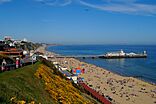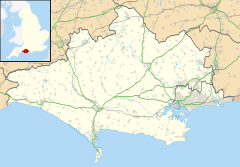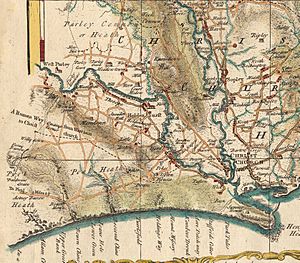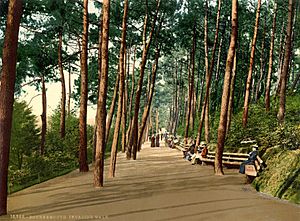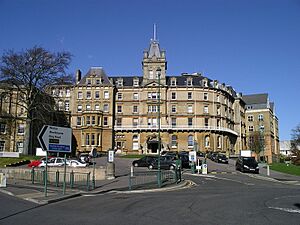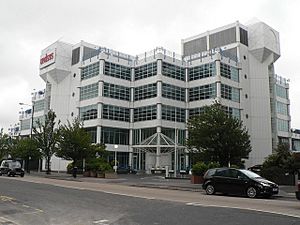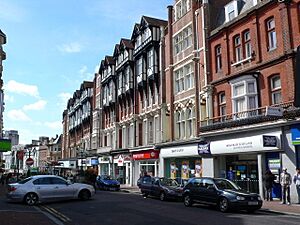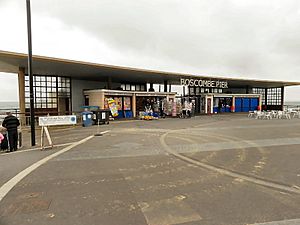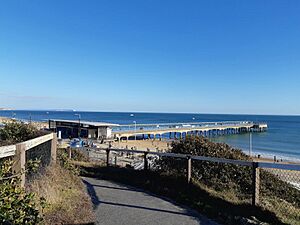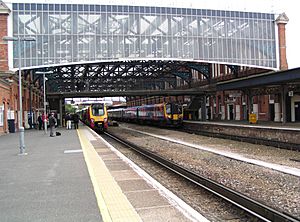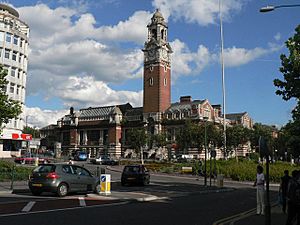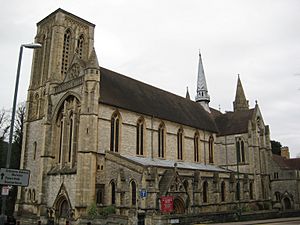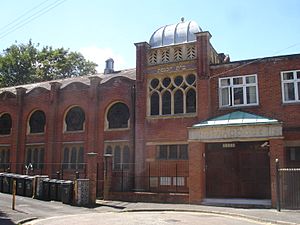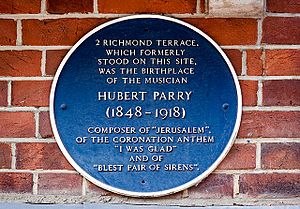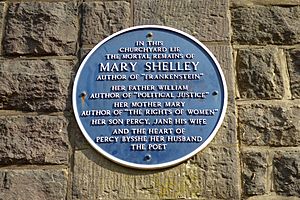Bournemouth facts for kids
Quick facts for kids Bournemouth |
|
|---|---|
| Town | |
|
Top to bottom, left to right: The seafront, the town hall, St. Peter's Church, Bournemouth Pier, the Pavilion Theatre and Bournemouth Gardens |
|
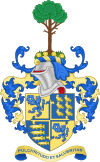 Bournemouth Coat of Arms |
|
| Area | 15.54 sq mi (40.2 km2) |
| Population | 196,455 (built-up area, 2021) |
| • Density | 12,642/sq mi (4,881/km2) |
| OS grid reference | SZ086912 |
| Unitary authority |
|
| Ceremonial county | |
| Region | |
| Country | England |
| Sovereign state | United Kingdom |
| Post town | BOURNEMOUTH |
| Postcode district | BH1-11 |
| Dialling code | 01202 |
| Police | Dorset |
| Fire | Dorset |
| Ambulance | South Western |
| EU Parliament | South West England |
| UK Parliament |
|
Bournemouth (![]() i/ˈbɔːrnməθ/ BORN-məth) is a lively coastal resort town in Dorset, England. In 2021, about 196,455 people lived here, making it the biggest town in Dorset.
i/ˈbɔːrnməθ/ BORN-məth) is a lively coastal resort town in Dorset, England. In 2021, about 196,455 people lived here, making it the biggest town in Dorset.
Long ago, Bournemouth was just an empty heathland visited by a few fishermen. But in 1810, Lewis Tregonwell started a health resort here. When the railway arrived in 1870, Bournemouth quickly grew into a popular holiday spot. Today, over five million people visit each year for its beautiful beaches and fun nightlife. The town also has a strong financial industry.
Bournemouth used to be part of Hampshire but became part of Dorset in 1974. It is now part of the Bournemouth, Christchurch and Poole Council, which also includes Poole and Christchurch. The town centre has many interesting Victorian buildings. St Peter's Church has a tall spire and is a very old and important building. Bournemouth also has big venues like the Bournemouth International Centre (BIC) and Pavilion Theatre for events and concerts.
Contents
- What's in a Name? The Story of Bournemouth
- Bournemouth's Journey Through Time
- How Bournemouth is Governed
- Where is Bournemouth? Its Geography
- Who Lives in Bournemouth? Demographics
- Bournemouth's Economy
- Bournemouth's Culture and Fun
- Famous Landmarks in Bournemouth
- Sports in Bournemouth
- Getting Around Bournemouth: Transport
- Learning in Bournemouth: Education
- Faith and Religion in Bournemouth
- Understanding "Bournemouth"
- Famous People from Bournemouth
- Twin Towns
- Freedom of the Borough
- See also
What's in a Name? The Story of Bournemouth
The name "Bournemouth" first appeared in a record from 1406. A monk wrote about a huge fish that washed up at "La Bournemowthe." This name simply described the area around the mouth of a small river. The word bourne means a small stream.
Later, people started calling it "Bourne Mouth," then just "Bourne." In 1831, a travel guide called it "Bourne Cliffe" or "Tregonwell's Bourne," after its founder. By the late 1800s, "Bournemouth" became the most common name.
Bournemouth's Journey Through Time
For thousands of years, the area around Bournemouth was mostly empty heathland. In 1574, someone described it as "Devoid of all habitation," meaning no one lived there. Before the 1800s, only a few fishermen or smugglers visited the mouth of the Bourne river.
In the early 1800s, a law changed how land was owned. This meant large parts of the heathland became private property. In 1812, Lewis Tregonwell, a retired army officer, and his wife became the first official residents. They built their home on land they bought. Tregonwell knew the area well from his time looking for French invaders and smugglers during the Napoleonic wars.
People believed that sea-bathing and pine-scented air were good for health, especially for lung problems. So, Tregonwell and another landowner, Sir George Ivison Tapps, planted hundreds of pine trees. Tregonwell also built villas to rent out to visitors. By the time he died in 1832, Bournemouth was a small community with houses and cottages. The town grew around these pine trees and the paths leading to the beach, which became known as the Invalids' Walk.
After Tapps died, his son, Sir George William Tapps-Gervis, continued developing the area. Bournemouth's first hotel opened in 1838. The town started growing faster, similar to other coastal resorts like Weymouth and Brighton. A doctor named Augustus Granville visited and wrote about Bournemouth in his book, The Spas of England. This helped the town become known as an early tourist destination.
In the 1840s, new plans for Bournemouth included creating gardens along the Bourne stream. These gardens, including the Invalids' Walk, are still part of the town today. A special hospital for recovery was built in 1855, making Bournemouth even more famous as a place to get well.
Since many visitors arrived by sea, a pier was needed. After some effort, a pier was approved in 1856. Several wooden piers were built before a strong cast-iron pier, designed by Eugenius Birch, was finished in 1880. This pier was 838 feet (255 meters) long.
The arrival of railways in 1870 brought a huge increase in visitors from places like London. By 1880, Bournemouth had 17,000 people, and by 1900, it had grown to 60,000. It became a favorite spot for artists and writers. Sir Merton Russell-Cotes, a local mayor, helped improve the town by setting up its first library and museum. The Russell-Cotes Art Gallery & Museum was his mansion, which he later gave to the town. Bournemouth became a borough in 1890.
In the early 1900s, the town centre got more theatres, cafes, and hotels. New buildings included a war memorial in 1921 and the Bournemouth Pavilion, a concert hall, finished in 1925.
During World War II, Bournemouth was not heavily bombed, but the seafront was fortified against invasion. Metal lampposts and benches were melted down for weapons. After the war, it took two years to remove all the barbed wire and mines from the beaches.
The Bournemouth International Centre (BIC), a large conference and exhibition centre, was built near the seafront in 1984. The next year, Bournemouth was the first town in the UK to use CCTV cameras for public safety.
In 1993, there was a terrorist attack in the town centre. Only minor injuries occurred, but it caused over £1 million in damage.
A building called the Waterfront complex, meant for an IMAX cinema, was built on the seafront in 1998. Many people disliked it because it blocked views of the bay. In 2005, it was voted the most hated building in England and was taken down in 2013. The site is now used for outdoor events.
In 2012, Bournemouth tried to become a city but was unsuccessful.
How Bournemouth is Governed
Bournemouth is governed by the Bournemouth, Christchurch and Poole Council, which is a single local authority. This council is based at the Civic Centre in Bournemouth.
Historically, Bournemouth was part of the parish of Christchurch in Hampshire. When Bournemouth started to grow in 1810, it was split between two parishes. In 1856, a group of commissioners was set up to manage local services like paving and street lighting.
Bournemouth officially became a municipal borough in 1890 and a county borough in 1900, which meant it was independent from Hampshire County Council. Its boundaries grew over time, adding areas like Pokesdown and Winton. In 1921, the council bought the former Mont Dore Hotel and turned it into the Town Hall.
In 1974, Bournemouth became a non-metropolitan district and was moved from Hampshire to Dorset. This was done so that the whole South East Dorset conurbation would be in the same county. In 1997, Bournemouth became a unitary authority, taking over more local government responsibilities.
Since April 2019, Bournemouth has been part of the new Bournemouth, Christchurch and Poole Council, along with Christchurch and Poole. This council combines the services of the previous local councils.
Where is Bournemouth? Its Geography
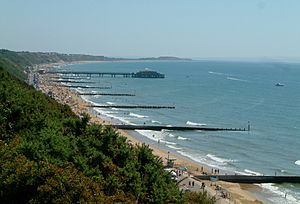
Bournemouth is about 94 miles (151 km) southwest of London. It shares borders with Poole to the west and Christchurch to the east. Poole Bay is to the south. The River Stour forms a natural boundary to the north and east, ending at Christchurch Harbour. The smaller River Bourne flows through the middle of Bournemouth town centre and into the English Channel.
Bournemouth, Poole, and Christchurch together form the South East Dorset conurbation, which has over 400,000 people. Bournemouth is a major shopping and business centre. Some areas within Bournemouth include Boscombe, Kinson, Southbourne, and Winton.
The area's land is mostly made of Eocene clays, which used to support a heathland environment. Some parts of this original heathland still exist, like Turbary Common. This habitat is home to all six types of native reptiles, special birds like the Dartford warbler, and unique plants. Small groups of Exmoor pony and Shetland cattle help keep the heathland healthy.
Bournemouth is just north of Old Harry Rocks, which is the eastern end of the Jurassic Coast. This 96-mile (155 km) coastline was named a World Heritage Site in 2001. Bournemouth's own coastline has sandy beaches backed by cliffs. These cliffs have natural gaps called chines that lead to the shore. At the eastern end is Hengistbury Head, a narrow piece of land that is a local nature reserve and was once a Bronze Age settlement.
Bournemouth's Weather
Bournemouth has a mild oceanic climate, like the rest of the UK. This means temperatures don't change too much, summers are cool, and it's often cloudy. The average temperature is between 10 and 11°C (50-52°F). July and August are the warmest months, while January and February are the coolest.
Bournemouth gets about 800 mm (31.5 inches) of rain each year, which is less than the UK average. The highest temperature ever recorded at Bournemouth Airport was 34.1°C (93.4°F) in August 1990, and the lowest was -13.4°C (7.9°F) in January 1963.
Who Lives in Bournemouth? Demographics
In 2011, Bournemouth had a population of 183,491 people, with slightly more females than males. The average age was 40 years old. Bournemouth has a high population density compared to other areas in the South-West of England.
Most of the population, 83.8%, are 'White British'. Other white groups make up 8.1%. Asian groups make up 3.9%, and Black groups make up 1.0%. People of Mixed race are 2.3% of the population.
In terms of religion, 57.1% of people identified as Christian. However, 30% said they had no religion, and 7.8% preferred not to say. Muslims made up 1.8%, while Buddhists, Hindus, and Jews each accounted for 0.7%.
Bournemouth's population has grown since 2001, partly because more people are moving into the area, especially students aged 16-24.
Bournemouth's Economy
Like much of Dorset, Bournemouth's economy mainly relies on the service sector. This means most jobs are in areas like finance, tourism, and public services. In 2010, 95% of workers were in the service sector.
The financial services sector in Bournemouth is very important, worth over £1 billion. Big companies like JPMorgan and Nationwide Building Society have offices here. While manufacturing is more common in nearby Poole, it still employs some people in Bournemouth.
Tourism is also a huge part of the local economy. In 2011, over 5.6 million visitors came to Bournemouth and spent more than £460 million. This supports about 8,531 full-time jobs, which is 15% of all jobs in the town. Bournemouth's seafront is one of the UK's biggest attractions.
Bournemouth is known for its lively nightlife, with many clubs, bars, and restaurants. This brings in £125 million a year and supports 4,000 jobs. In 2010, the town received a "Purple Flag" for offering a wide range of safe night-time activities.
Most of Bournemouth's working-age population is employed, though not all work within Bournemouth itself. The biggest job sectors are public administration, education, and health, followed by distribution, hotels & restaurants, and banking, finance & insurance.
The town centre has many shops, including modern malls, Victorian arcades, and a variety of cafes. Westover Road is known for its high-end shops. North of the centre is Castlepoint, a large shopping complex that opened in 2003. Other major shopping areas are in Westbourne and Boscombe.
Bournemouth's Culture and Fun


Bournemouth is a popular place for fun, entertainment, and culture. With its large university population and many language students, it has a lively youth culture. It's also a popular spot for nightlife. In a 2007 survey, Bournemouth was found to be the happiest place in the UK!
Major places for concerts include the BIC, Pavilion Theatre, and O2 Academy. The BIC, built in 1984, is the largest venue on the south coast. The O2 Academy, opened in 1895, used to be a circus and music hall. The Pavilion, opened in 1929, still hosts West End shows, ballet, and operas.
Bournemouth has over 200 listed buildings, mostly from the Victorian and Edwardian times. Three churches, St Peter's, St Clement's, and St Stephen's, are especially important.
The Russell-Cotes Museum is a beautiful villa from 1901. It holds amazing items and paintings collected by Merton Russell-Cotes and his wife during their travels. The museum has four art galleries with works by famous artists. Russell-Cotes also helped create the promenade that runs along the Bournemouth and Poole coastline.
The Lower, Central and Upper Gardens are beautiful public parks that stretch for several miles through the town centre to the sea. Bournemouth has another 425 acres (172 hectares) of parkland, including King's Park and Queen's Park.
The Bournemouth Symphony Orchestra is a famous musical group. It was formed in 1893 and became the country's first municipal orchestra in 1896. Today, it performs about 130 concerts a year across Southern England.
Bournemouth hosts several festivals. The Bournemouth Food and Drink Festival is a ten-day event with markets and cooking shows. The Arts by the Sea Festival features dance, film, theatre, and music. The Bourne Free carnival celebrates diversity and inclusion.
Since 2008, Bournemouth has held its own air festival every August. It features amazing displays from planes like the Red Arrows and historic aircraft. This festival attracts up to a million people! The Bournemouth 7s Festival is a sports and music festival in May, with tournaments in rugby, netball, and other sports.
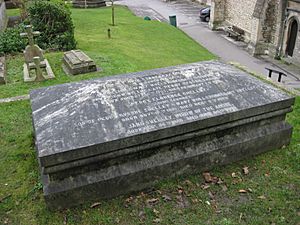
Many famous writers have connections to Bournemouth. J. R. R. Tolkien, author of The Lord of the Rings, spent 30 years taking holidays in Bournemouth and retired here.
Sir Percy Shelley, 3rd Baronet, built a house in Boscombe for his mother, Mary Shelley, who wrote Frankenstein. Mary Shelley is buried in Bournemouth, in St Peter's churchyard, along with her parents William Godwin and Mary Wollstonecraft, and the heart of her husband, Percy Bysshe Shelley.

Robert Louis Stevenson wrote The Strange Case of Dr. Jekyll and Mr. Hyde and much of Kidnapped from his house "Skerryvore" in Westbourne. The author Roald Dahl set his novel The Witches in a luxury hotel in Bournemouth.
Famous Landmarks in Bournemouth
Bournemouth has many historic landmarks, mostly from the Victorian and Edwardian era.
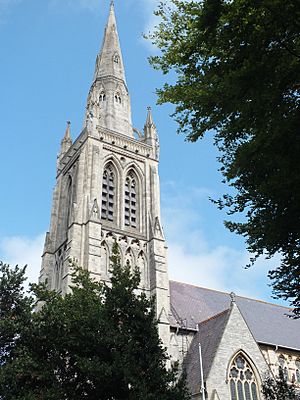
Bournemouth has three very important churches: St Peter's and St Stephen's in the town centre, and St Clement's in Boscombe. St Peter's was the town's first church, finished in 1879. Its 202-foot (62-meter) spire stands out in the skyline.
The borough has two piers: Bournemouth Pier near the town centre, and the shorter but unique Boscombe Pier. Boscombe Pier opened in 1889 and was extended in 1927. Its boomerang-shaped entrance kiosk from 1958 is now a listed building. In 2009, a fashion designer called Boscombe Pier "Britain's coolest pier."
Bournemouth Pier started as a simple wooden jetty in 1856. It was replaced by a longer wooden pier, then a cast-iron one in 1880. After World War II, a Pier Theatre was added in 1960, which later became a climbing adventure centre.
Bournemouth Town Hall was built as the Mont Dore Hotel in 1881. It's a beautiful building with French, Italian, and neo-classical styles. During the First World War, it was used as a hospital. In 1919, Bournemouth Borough Council bought it and turned it into the Town Hall. Other Victorian hotels include the Royal Bath Hotel and the Norfolk Royale Hotel.
The Pavilion Theatre, built in the Art Deco style in 1929, is near the seafront. It was considered a great achievement for entertainment at the time. It's still a popular venue today.
The Bournemouth Eye was a large helium balloon that offered amazing panoramic views of the area from 150 meters (492 feet high). It was located in the town's lower gardens. However, it was removed in 2017 due to high operating costs.
Bournemouth is famous for having only one "street," which is Orchard Street. It's a small alley that existed before the modern town was built. The early developers preferred names like Road, Avenue, and Drive, thinking "Street" sounded less grand.
Sports in Bournemouth
Bournemouth has a professional football club, AFC Bournemouth, known as the Cherries. They play in the Premier League at Dean Court stadium near Boscombe.
Bournemouth Rugby Club plays at Bournemouth Sports Club. It hosts an annual Bournemouth 7s Festival, which is the world's largest sport and music festival. It includes rugby, netball, hockey, and dodgeball tournaments. Oakmeadians RFC is the oldest rugby club in Bournemouth.
Bournemouth Cricket Club is one of the biggest in the country. Dean Park Cricket Ground used to be a county cricket ground and is now used for university cricket.
The BIC hosts a round of the Premier League Darts Championship.
The Bournemouth Rowing Club, established in 1865, is the town's coastal rowing club. They compete in regattas along the south coast.
Other popular water sports in Poole Bay include sailing and surfing. Bournemouth has one of the largest surfing communities in the UK. In 2009, an artificial surf reef was built, but it had problems and cost a lot of money.
The town also has a team for Octopush, also known as underwater hockey.
Getting Around Bournemouth: Transport
Trains
Bournemouth is the main train station. Pokesdown serves the east, and Branksome serves the west. All three stations are on the South West Main Line, connecting to London Waterloo in the east and Weymouth in the west.
South Western Railway runs frequent services on this line, connecting Bournemouth to cities like Southampton and Winchester.
Roads
The main road into Bournemouth town centre is the A338, which connects to the A31. The A31 then links to the M27 and M3 for routes to London and the Midlands.
The A35 goes west to Honiton in Devon and east towards Southampton. The A350 in Poole is the main route north out of the area.
Buses and Coaches
Local bus services are run by Morebus, connecting Bournemouth to nearby towns like Christchurch, Poole, and Ringwood.
Yellow Buses, a former council-owned company, stopped operating in 2022.
National Express coaches serve Bournemouth Travel Interchange and Bournemouth University, with frequent services to London, Gatwick Airport, and other towns.
Air Travel
Bournemouth Airport is located near Hurn in Christchurch, about 4.5 miles (7.2 km) from Bournemouth town centre. It was originally an RAF airfield. Before Heathrow Airport opened, it was the UK's only intercontinental airport.
The airport serves about 600,000 passengers each year, with direct flights to 23 international destinations in nine countries, including Spain, Portugal, and Greece.
Learning in Bournemouth: Education
Bournemouth has a traditional two-tier education system. Students attend one of 26 primary schools before going to secondary school. Bournemouth is one of the few areas in England that still has selective education, meaning there are two grammar schools (one for boys, one for girls) and ten non-selective secondary schools. There are also some independent schools.
Bournemouth and Poole College offers further education and other courses. Bournemouth is home to two universities: Bournemouth University and Arts University Bournemouth. Both are actually located just over the border in Poole. AECC University College (formerly Anglo European College of Chiropractic) is also in Bournemouth.
In 2012, 60.7% of school leavers in Bournemouth achieved 5 GCSEs at grade C or above, which was slightly better than the national average.
Faith and Religion in Bournemouth
The 2011 census showed that 57.1% of people in Bournemouth are Christian. All other religions combined make up only 4.7%, making Christianity the largest religious group.
Most of Bournemouth is part of the Church of England Diocese of Salisbury, while the eastern part belongs to the Diocese of Winchester. The Roman Catholic Diocese of Portsmouth covers most of Bournemouth.
The borough has several beautiful Victorian churches. St Peter's is famous for having the grave of author Mary Shelley. St Stephen's Church, completed in 1898, and St Clement's, built in Boscombe in 1871, are also notable. The largest church in town is Richmond Hill St Andrew's Church, part of the United Reformed Church, which can seat 1,100 people.
While most places of worship are Christian, Bournemouth has a higher number of Jewish residents than the national average, with three synagogues. The Bournemouth Reform Synagogue has over 700 members. The Bournemouth Hebrew Congregation synagogue, built in 1911, has a unique Art Nouveau and Moorish Revival style.
The Bournemouth Islamic Centre provides support and a place of worship for the Islamic community. There is also a separate mosque in the town.
Understanding "Bournemouth"
The name "Bournemouth" is sometimes used to describe the larger area called the South East Dorset conurbation, which includes nearby towns like Poole, Christchurch, and Wimborne Minster. This can sometimes be a bit confusing:
- Even though it has a presence in Bournemouth town centre, Bournemouth University's main campus is actually in Poole.
- Bournemouth Airport is located near Hurn in the borough of Christchurch.
- "Bournemouth Bay" is sometimes used to refer to Poole Bay.
- The Bournemouth Symphony Orchestra is now based in Poole.
Famous People from Bournemouth
Many famous people have come from Bournemouth or lived here. Tony Hancock, a famous comedian, spent much of his early life in Bournemouth hotels.
Several actors are from Bournemouth, including Juliette Kaplan, Ray Lonnen, Alison Newman, Jack Donnelly, Sophie Rundle, and Ben Hardy. Famous actors Christian Bale and Millie Bobby Brown also lived in Bournemouth during parts of their childhood.
The composer Sir Hubert Parry (1848–1918), known for "Jerusalem," was born in Bournemouth. Andy Summers, the guitarist from the famous band The Police, grew up in Bournemouth. Alex James, the bassist from the band Blur, went to school here.
Bournemouth has also been home to sports champions like Freddie Mills, a boxing world champion, and Charles Bennett, the first British track and field Olympic Champion. Tennis star Virginia Wade was born in Bournemouth.
The heart of Percy Bysshe Shelley, a famous poet, is buried in St Peter's Church, Bournemouth churchyard, along with his wife Mary Shelley and her parents Mary Wollstonecraft and William Godwin.
Twin Towns
Bournemouth is twinned with:
- Netanya, Israel
- Lucerne, Switzerland
Freedom of the Borough
Some people and military units have been given the special honour of "Freedom of the Borough" in Bournemouth.
Individuals
- Frederick Roberts, 1st Earl Roberts: 1902.
- Sir Winston Churchill.
- Sir Geoffrey Hurst.
- Sir Christopher Hoy.
- Bob Geldof.
- Eddie Howe: 2019.
Military Units
- The Royal Hampshire Regiment: 1945.
See also
 In Spanish: Bournemouth para niños
In Spanish: Bournemouth para niños





